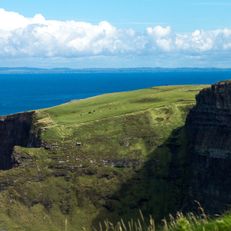Ireland Traffic Guide
Driving Through Ireland
Ireland, known as the "Emerald Isle," boasts seemingly endless picturesque landscapes. To see as much as possible of the diverse island with its green meadows and impressive cliffs, it's worth tackling the challenge of left-hand traffic and embarking on a road trip.
In this guide, learn more about the traffic rules of the Republic of Ireland, as well as the road conditions and the fuel and charging situation on the island.
Ireland Traffic Rules Overview
- In Ireland, individuals can drive from the age of 17, and the EU driver’s license, which is also common in Germany, is sufficient as a driving permit.
- The entire island of Ireland follows left-hand traffic. Accordingly, overtaking is done on the right, and roundabouts are navigated clockwise. However, the right-before-left rule applies if priority is not indicated by signs.
- The speed limit within built-up areas is 50 km/h and 80 km/h outside built-up areas. On expressways, the speed limit is 100 km/h, and on motorways, it is up to 120 km/h.
- In Ireland, all vehicle occupants must wear seat belts while driving. The driver must not use a mobile phone unless a hands-free system is used. Lights must be turned on in darkness and poor visibility.
- Unlike most European countries, no safety equipment is mandated in vehicles in Ireland. However, it is strongly recommended to carry a first aid kit, high-visibility vests, and a warning triangle.
- The legal alcohol limit in Ireland is 0.5 per mille. Novice drivers and professional drivers must not exceed a limit of 0.2 per mille.
- Smoking in the vehicle is prohibited if a person under 18 is present.
Driving in Ireland
The Roads in Ireland
The roads in Ireland are generally in very good condition. In particular, the motorways and expressways, as well as the roads within cities, are excellently developed.

Outside the cities on country roads, you should watch out for potholes and single-lane passages with oncoming traffic. Additionally, you may encounter sheep herds that sometimes also use the road.
Particularly dangerous passages are usually marked with traffic signs. Hazard signs in Ireland are upside-down triangles with a yellow background and a black symbol.
Many warning signs are self-explanatory, such as a sheep to warn of sheep herds, arrows to indicate sharp curves, or a whirlwind symbol for crosswinds.
Petrol stations and charging points
Petrol and Diesel: Ireland has a plentiful number of petrol stations, especially along major roads where finding a place to refuel is generally not a problem.
In rural areas, petrol stations are open during daytime hours on weekdays. In larger cities like Dublin and along motorways, you can also find stations that are open 24/7 or at least offer a self-service option.

Electric Cars: Compared to other European countries, Ireland boasts a particularly dense network of charging stations for electric vehicles.
Finding a charging option for your electric car in Ireland is significantly easier than in countries like Germany. If you have been hesitant to travel abroad with an electric car, Ireland is an excellent choice for your first experience with electromobility.
Hydrogen Cars: There are a few hydrogen fuel stations in Ireland. With proper planning, it is indeed feasible to travel around the island using a hydrogen-powered vehicle.
Rental car or own car?
It is possible to reach Ireland by ferry with your own car. Ferry connections from the mainland, for instance from France or Spain, head towards the Emerald Isle. Alternatively, you can first cross to England by ferry or car train and then take another ferry connection to Ireland.
For entry into Ireland, your car must have motor liability insurance, which can usually be proven with a EU license plate. However, it is advisable to also carry the International Insurance Card, especially if you are entering through England.
Those who wish to drive their own car in Ireland should also remember that the island has left-hand traffic, and a vehicle designed for right-hand traffic can make the adjustment more difficult. Therefore, it might be advisable to rent a car locally that is fully suited for driving in Ireland.
Rental cars are especially available at airports and in cities. Typically, car rental companies lend their vehicles only to individuals between the ages of 21 and 70 who have had a driver's license for at least two years.
Fines
In Ireland, fines for most traffic violations are comparatively low. However, driving under the influence of alcohol is subject to higher penalties.

Excerpt from the fine catalog:
- Speeding: from 80 Euros (approx. £70)
- Seatbelt violation: from 60 Euros (approx. £50)
- Driving under the influence of alcohol (up to 0.8 per mille): 200 Euros (approx. £170)
- Driving under the influence of alcohol (up to 1.0 per mille): 400 Euros (approx. £340)
- Red light violation: from 80 Euros (approx. £70)
- Using a mobile phone while driving: from 60 Euros (approx. £50)
- Parking violation: from 40 Euros (approx. £35)
Conclusion: Road Traffic on the Emerald Isle
Ireland dazzles with its breathtaking landscapes and pleasant road conditions. Once you get accustomed to the unusual left-hand traffic, you can relax and explore the island with your own car or a rental car. Ireland not only has numerous petrol stations but also a well-developed network of charging stations for electric vehicles, ensuring a comfortable travel experience even with an electric car.
► Here you can find more information about the toll regulations in Ireland, to be optimally prepared for your trip.






